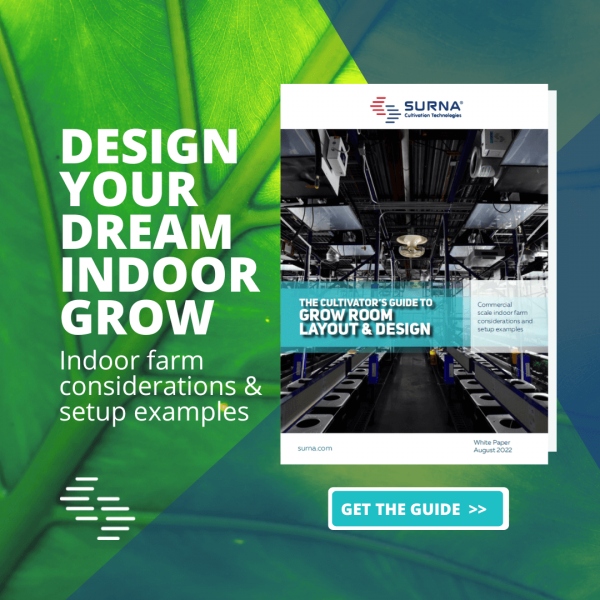There are a lot of myths that surround cooling needs in the cannabis industry. Let’s delve into some of the most common ones we hear.
Bringing in outside air is necessary to replenish oxygen levels in a garden.
The thought process: CO2 is added to aid plant growth, so bringing in outside air adds necessary oxygen so people can breathe.
Fact: Plants consume CO2 and expel Oxygen. This is the opposite of humans who consume oxygen and exhale CO2, which is the basis of this myth. In human occupied buildings, with no plants, adding fresh air is often necessary in order to replenish oxygen levels in the air. However, in cultivation centers, there are enough plants and few enough people to make this unnecessary. Bringing outside air into a grow can actually be detrimental to plant health because it allows pests and pathogens to get in and can disrupt the delicate temperature and humidity balance desired for optimal plant growth.
The amount of cooling needed is based on square footage.
The thought process: Typical residential and commercial buildings base cooling and heating requirements on square footage, so the same process should be used for cultivation.
Fact: Cooling load for a cultivation center should be based on the number of lights in the facility. The lights in a cultivation center provide enough heat that the cooling needs are considered process cooling, which is different from the comfort cooling needs of homes and most commercial buildings. In cultivation centers, the goal is heat removal, not making a space comfortable for human occupation. The heat load, and thus cooling needs of a cultivation center, are more closely related to a data center than a typical residential building and are considerably higher.
I don’t need cooling because I live in a cold climate, heating is more of a concern for me.
The thought process: My house and very few of the commercial buildings I go to have cooling because it rarely gets hot enough here to need it, so keeping my garden cool won’t be an issue.
Fact: Grow lights add a lot of heat to a cultivation facility and will quickly overtake your building’s natural ability to cool. Because so much heat is being added to the room from the lights, heating is likely to be a smaller concern than you realize, while cooling will be a larger concern.
Sealed grow rooms are minimally impacted by the outside climate and need to be properly climate controlled in their own right. While there are ways to get practically free cooling in colder climates, the grow room will still need to be cooled.
As for heating, in very cold climates, it may be necessary to add some heat to the garden, but it will not be as much as is needed for a typical building, due to the heat from the lights.
LEDs produce less heat than HID bulbs.
The thought process: LEDs do not feel as hot, so they must not put off as much heat as HID bulbs.
Fact: Watt for watt, the same amount of heat is produced by both LEDs and HID bulbs; however, LEDs are often a lower wattage than HID bulbs, making them seem cooler. LEDs are not 100% efficient, so not all of the energy consumed by the fixture ends up as useable light, and what is not used to create light ends up as heat.
Cooling a room involves the addition of cold air.
The thought process: Air coming out of the vents feels cold, so cold must be being added.
Fact: Cooling is actually the removal of heat, not the addition of cool. Read our blog post: “Cooling: The Removal of Heat” for more information.
This one isn’t directly related to cooling, but it can affect the humidity in your grow, and it is one we hear a lot, so we’ve included it here as well:
It takes a lot of water to grow plants indoors.
The thought process: It is estimated to take 6 gallons of water per day per plant.
Fact: It is possible to save water when growing indoors due to water reclamation, which is not possible when growing outdoors or in greenhouses. All water not directly consumed by the plant eventually makes its way into the air as humidity. In indoor cultivation, it is possible to collect condensate pulled from the air and reuse the water, which is not possible when growing outdoors or in greenhouses. This ability to collect condensate and reuse the water means growing indoors requires less water than other growing styles.

